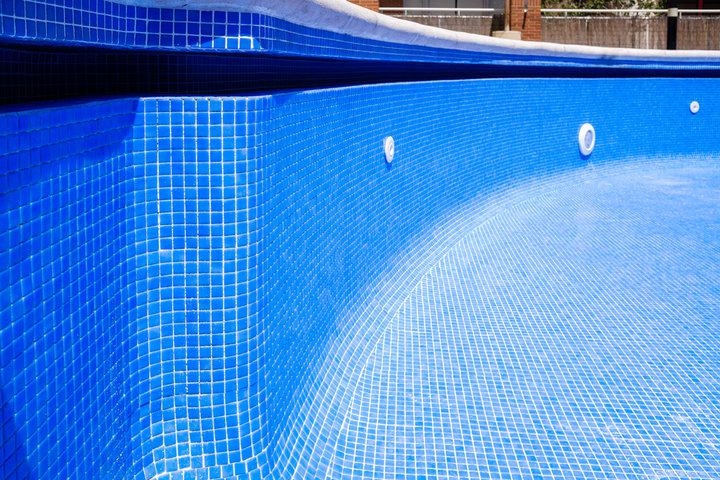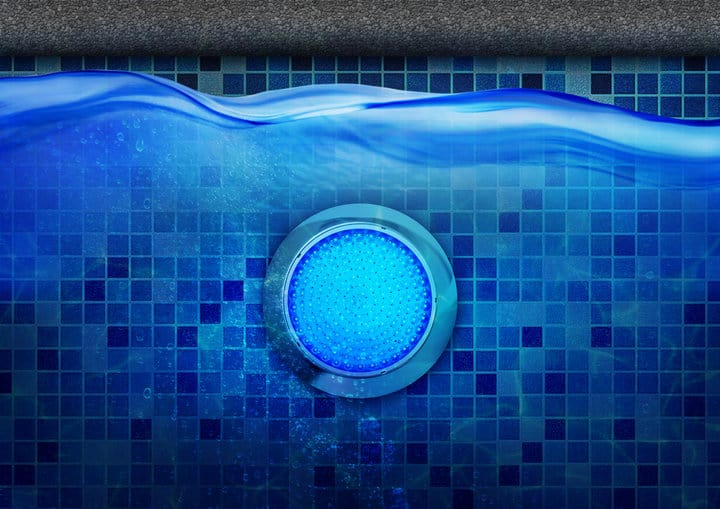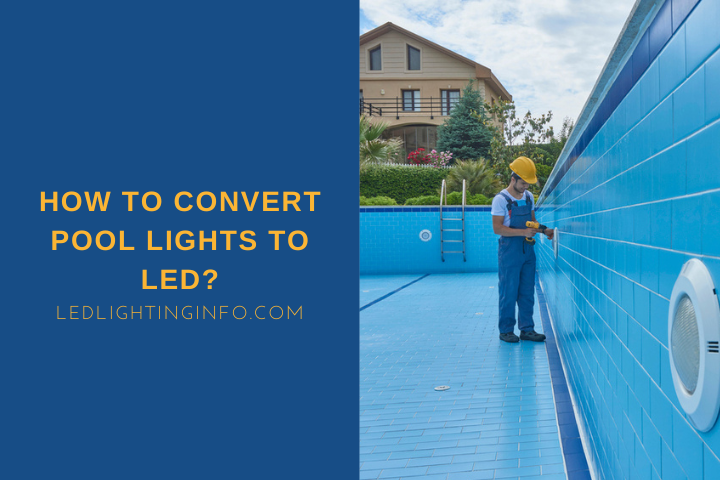Are you looking to convert your old pool lights to a more modern option that can last longer and won’t use as much energy?
If you use pool lights regularly, there are many good reasons to switch to LEDs if you’re still using older incandescent or halogen bulbs.
Changing to LED can sometimes be a quick job, and sometimes it takes a little more effort – but it’s not too bad once you know how.
Unless you’re just swapping the bulb, the best way to upgrade to LEDs is to use the wire for the old light as a fishing line. Tape the new cable to the old one, and pull the wire through from the transformer or mains.
There are a couple of other steps to consider, so let’s look in detail at the following:
- How you convert incandescent pool lights to LEDs
- The main things to watch out for with low-voltage LEDs
- Whether you need to drain the water to swap your lights
How To Convert Incandescent Pool Lights To An LED?

Converting incandescent pool lights (or halogen lights) to LEDs can be done in one of two ways.
That’s because incandescent and halogen lights work just like most fixtures inside your home – they have a fixture, and inside is a light bulb.
When the bulb burns out, you need to replace the bulb inside the fixture.
You can still do that for your pool lights if you want to.
You can buy E26 LED bulbs that screw into the existing fixture (provided yours is a standard fixture – always check before you buy a new bulb).
Most LED pool lights are self-contained units designed to replace the entire fixture. This is a bigger job, but it’s not too difficult.
The good news is you don’t need to drain your pool for either option.
Here’s a step-by-step for both types of light replacement.
- Turn off the power. This might seem obvious, especially in a pool, but I must mention it.
- Unscrew the light fixture from the pool wall. It will likely be held in place by three screws. If you can’t see the screws easily, use goggles and do it with your head underwater.
- Pull the fixture away from the wall. It should if it was installed following the NEC code, have enough cable flex for you to remove it from the pool and place it on a towel on the pool edge.
- Remove the cover for the light. This will be held in place by a gasket, you may unclip it, but normally there’s a bolt that needs to be unscrewed.
- Unscrew the old bulb and set it aside. Screw the replacement bulb into place.
- Replace the cover, making sure the seal is completely tight. It’s usually a good practice to replace the gasket every time you switch the bulb.
- Put the fixture underwater and check that no bubbles are coming from it.
- Reinstall the light, using just the main screw at the top for now.
- Test that the light works by switching the power back on.
- If it is, screw in the remaining two screws.
If you’re replacing the entire fixture, your new LED light will come with the cable attached – this keeps the seal waterproof at the fixture.
You’re going to feed the new cable through your existing conduit. So it’s pretty easy.
First, follow steps one to three from the previous guide. They are the same for both types.
- With the power still off and the old fixture on the pool edge, cut the cable of the old light near the light.
- Your new light will come with brackets to fit it to the wall. Find the one that suits your hole, and then pass the new cable through the middle of this bracket. Don’t forget this step!
- Tape this cable to the new cable for your pool light. Wrap both cables in a lot of waterproof electrical tape so that the bare cables aren’t exposed. Make sure the cables are very secure, as you’re about to put them through a bit of a stress test.
- Go to where the cable is connected to the power – either at the transformer or the circuit breaker if the lights were previously rated for mains voltage. Disconnect the wires.
- Grab hold of the old cable at the power source that is now disconnected and pull. You’re going to pull the old cable out from the power source end, and because it’s taped to the new cable, you’re pulling the new cable through the conduit and up to the power source. Before you pull the wires, ensure that the new fixture is long enough to reach your transformer.
- Once you’ve pulled the cable through until you have the new cable at the power source, remove the tape and dispose of the old cable.
- Strip the new cable back if necessary to expose the wires inside. Connect these at the power source – live to live, neutral to neutral, and ground to ground.
- Install the bracket for the light onto the recess hole. This is why you needed the cable to already be fed through it.
- Then attach the light to the bracket, using just one screw for now until you’ve tested the light works.
Here is a video guide if you prefer to see it in practice.
Since all the steps are covered now, let me share some tips.
When you remove the old fixture, note how the excess cable is stored in the recess – you’ll want to mirror that when you install the new light.
Ensure the old cable from the old light, and the new cable are securely bound together.
If they come apart while you’re pulling them through, then you won’t be able to pull the new cable through.
In this case, use electrical wire and feed it through the conduit from the power source.
You should be able, with some work, to get it to bend along the pipe until it comes out in the pool, where you can remove it, attach it to the new light cable and try again.
It’s best to replace lights with a second person – one keeping the new light secure by the poolside while the other pulls.
If you do it alone, secure your new light – you want to avoid damaging it by accidentally jerking it around as you pull on the cord.
Always test new lights when they are submerged only. Pool lights are not designed to be switched on when they aren’t surrounded by water; otherwise, they overheat.
Finally, if you’ve swapped the light bulb, replacing the gasket with the bulb is a good idea.
Once you have replaced the gasket, test it by holding the light under the water for a few seconds once you’ve resealed it.
If any bubbles escape from around the gasket, that tells you there’s a weakness, which will leak water.
You need to reseal the fixture.
Main Watchouts When Converting Lights To Low Voltage LEDs

If you’re replacing old incandescent or halogen bulbs with LED bulbs, then you must choose bulbs that fit into the fixture.
While most pool lights will likely use E26 bulbs, it might not always be the case. Therefore, it’s best to remove the old bulb and check it before you buy a new one.
The other thing to consider is wattage – they aren’t equivalent. LEDs are much brighter for the equivalent wattage, and a 40W LED bulb will be about as bright as a 300W halogen or incandescent.
Whether replacing a bulb or swapping the entire fixture, the only other consideration is voltage – and whether you need a transformer.
Do LED Pool Lights Require Transformer?
Most LED pool lights are low voltage lights and, therefore, should only be powered via a transformer which steps the voltage down from the mains voltage.
But check the lights that you’re buying, as some are rated for mains voltage and don’t need a transformer.
When replacing lights, your old incandescent or halogen lights may be low voltage. So you may already have a transformer in place.
If you already have a transformer, then make sure you buy 12V LED lights.
If you don’t, you can choose between connecting LED lights designed for the mains or installing a transformer and using low-voltage LEDs instead.
It may be more work, but 12V lights are significantly safer than mains voltage lights.
If there was a fault and they electrocuted you, 12 volts is unlikely to kill you.
Mains voltage lights are much more likely to be fatal if they electrocute you.
Do I Have To Drain Water When Converting To LEDs?

The good news is that you don’t need to drain your pool water when you’re converting your pool lights to LEDs.
As long as the power is off, everything can be done with the pool still full.
You don’t want water to get into your light’s wiring, but the cables are sealed into the light.
Ensure you use waterproof tape when sealing the other end of the cable to the old cable to pull it through the conduit to the power source.
Final Words
Replacing old pool light bulbs with LED bulbs is simple, but they’re not very common, and most people prefer to replace the entire fixture.
It’s relatively easy to follow the steps in this guide because you can use the old cable to pull the new one through.
If you use solid waterproof tape, there should be no awkward fishing through cables.
Have you made the decision to replace your pool lights with LEDs? Or have you encountered any issues when you’ve tried to do it yourself?

